- English
- Français
- Nederlands
Table of Contents
Study on Temporal Variations Between the Worlds
Introduction
by Sylvain St-Pierre
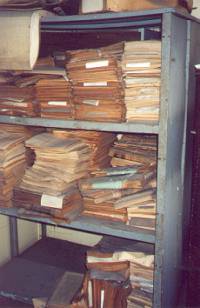 If the true origin of the Testament of Mary is still to this date very mysterious, we are in a position to be more specific regarding the curious document here attached.
If the true origin of the Testament of Mary is still to this date very mysterious, we are in a position to be more specific regarding the curious document here attached.
It was discovered on July 30, 1999, when some of the participants to the First Obscure Convention slipped into a Passage leading straight from Brussels to the former offices of l'Echo des Cités. Sadly, we never did leave the building itself, and are therefore unable to tell where exactly on the Continent it can found.
What is certain is that, despite the fact that they have obviously been abandoned for many years, these chambers still contained an incredible quantity of more or less intact documents, spread all over haphazardly. The temptation to examine them all in detail was great, but we knew about the volatile nature of Passages, and common sense demanded that we not stay any longer than necessary.
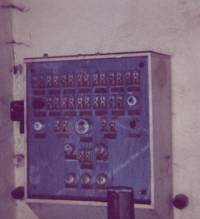 After an all too short visit, we were then on our way out when my attention was drawn to a strange device that was giving out a faint humming sound. That, in itself, was quite strange, for the electrical supply had obviously been cut long ago. A wire running along the wall quickly provided the answer to this mystery: a small generator had been mounted on a window ventilator. In a warm day, such as was the case during our visit, the colder air from the inside of the building was being pushed out, making the vanes rotate and producing a small amount of current.
After an all too short visit, we were then on our way out when my attention was drawn to a strange device that was giving out a faint humming sound. That, in itself, was quite strange, for the electrical supply had obviously been cut long ago. A wire running along the wall quickly provided the answer to this mystery: a small generator had been mounted on a window ventilator. In a warm day, such as was the case during our visit, the colder air from the inside of the building was being pushed out, making the vanes rotate and producing a small amount of current.
Did this machine cause the opening of the Passage? It was a tempting hypothesis, but to tamper with the device would have been sheer madness. However, a massive metallic file cabinet located nearby did offer the more irresistible seduction of a single wide open drawer.

A quick look confirmed my uncanny suspicion: several sheets of paper had been thrown in, apparently with great haste. Obeying a sudden impulse, I quickly grabbed the sheets and put them in my bag, hastily rejoining my companions, who were already leaving. The sheets, a dozen of them altogether, were for the most part in a very sad state, and my first reaction was to ask myself what madness had pushed me to take them in the first place. A closer examination did however dispel my doubts. Under the grime, the spots and the dust, one could make out diagrams and tantalising portions of text. What secrets was I going to discover? A considerable amount of restorative work has been needed to make this one single document somewhat readable, but the result, I think you will agree, has been well worth it.
Evolution of the Theories Regarding the Temporal Variations Between the Lighted World and the Obscure World.
By Professor Quint Stone, Rector of the College of Immaterial Studies of Luna.
[ continued from page 12 ] with an exactitude that has been often demonstrated. Those few paragraphs, then, represent only an extremely condensed picture of the state of the sciences in this domain; a distillate the effluvium of which, I hope, will awaken in the reader the desire to deepen his knowledge of the topic.
The Theory of the Wheels of Time
It is probably the very first theory built to explain the differences in the rate of the flow of time between the two worlds, and traces of it have been found in some of the most ancient strata (fig.1). It retains still to-day, despite its obvious shortcomings, many supporters.
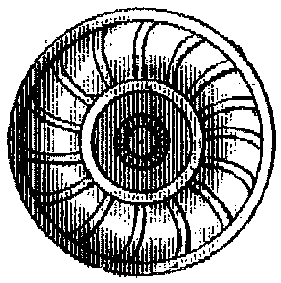
Truly, it would be more accurate to speak of an analogy rather than an actual explanation. According to this theory, we can liken the Obscure and Lighted Worlds to points located on the rim of two wheels of different diameters, revolving at the same rate (fig. 2). For each full turn, the point located on the larger wheel will have covered a greater distance that the one located on the smaller wheel. If we take this distance as a representation of Time, then the perceived value of Time spent will be greater in one world than in the other.
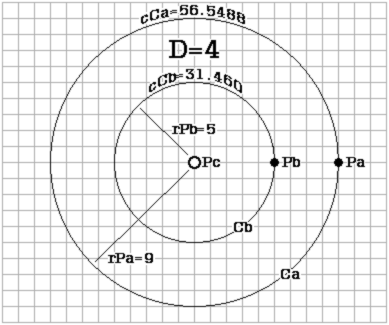
Algebraically speaking, it is a kindergarten problem. We only need to compare two different dates in each of the two worlds and do a simple set of calculations (fig. 3). In the classical theory, the temporal rate “D” between the two worlds was very early arrested at the mystical value of 9, and for a long time that figure was not disputed. The few variations occasionally observed were blamed on the rarity of the already irregular Passages; the difficulties of taking objective measurements and the multitude of complex calendars in use since the days of The Tower.
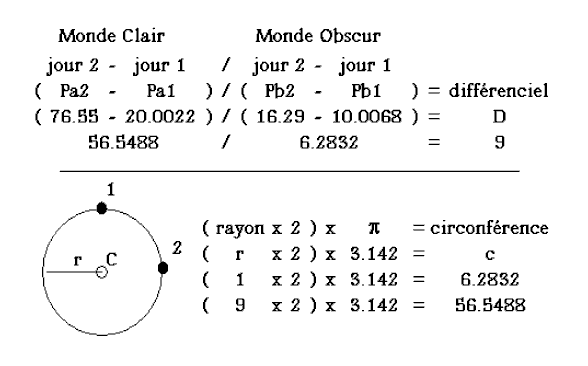
With the reported Passages becoming more and more numerous, we never the less had to surrender to the weight of evidence: the more data was gathered, the harder it became to reconcile the observations with the theory's predictions. It seemed that the difference in the rate of the flow of Time between the two worlds was not a constant value! Many a theorist ended up pulling his hair out, and the sad cliché of the philosopher hacking away at clocks with a hammer was for years a popular joke of dubious taste. Obviously, a new explanation was needed.
The Theory of the Temporal Spheres
This explanation came in the form of a synthesis between the Theory of Wheels and the one, somewhat forgotten since the days of the great Kepler, of the Celestial Spheres. Concocted in remote times, and almost mystical, the Theory of Celestial Spheres was one of the first lucid explanations of the apparent motion of the various planets of our solar system.
We know that worlds such as Psyché and Astarté seem in turn to advance and back-track in the night sky, at rates that are more or less variable. This has been attributed to the fact that the planets might be affixed to transparent spheres, themselves attached to greater spheres, part of systems vaster still. A model capable of exactly rendering all the planets' motions has never been made, but some of the better ones, like those of Karl Theiss, are of a great beauty (fig. 4).
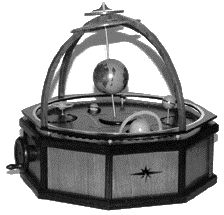
Since it was already accepted that a wheel might represent Time, it was a simple matter to adapt the celestial model (fig. 5).
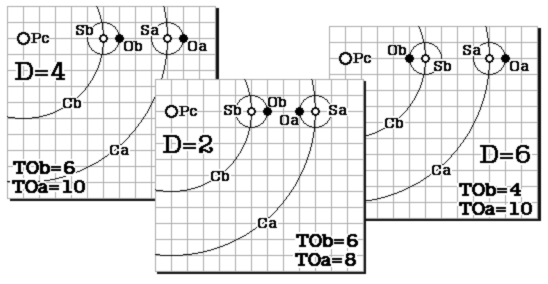
If Oa and Ob both “orbit” around Pa and Pb at the same rate, then their respective “absolute” temporal speed will vary depending on their distance from their common center, but will remain constant relative to one another. However, if those rates are different, the points will be sometimes closer (D=2) and sometimes further (D=6) from each other.
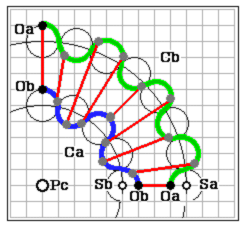
A variant of this theory suggests sub-orbits of a different diameter for each of the universes, but the difference is minor and the basic principle remains the same.
The Theory of the Chronotic Axis
There remained a detail, but a major one, to solve: how to explain those observations where everything indicated that Time could sometimes flow faster in the Obscure World than in the Lighted one? Although very rare, those observations seemed solid and impossible to ignore: the notes of Professor Gøhsay establish this beyond the shadow of a doubt. Should we reject the elegant Theory of the Spheres? The search for a solution to this problem sparked a most lively debate!
An interesting suggestion is that the sub-orbits can somehow periodically fluctuate, contracting and expanding (fig.7).
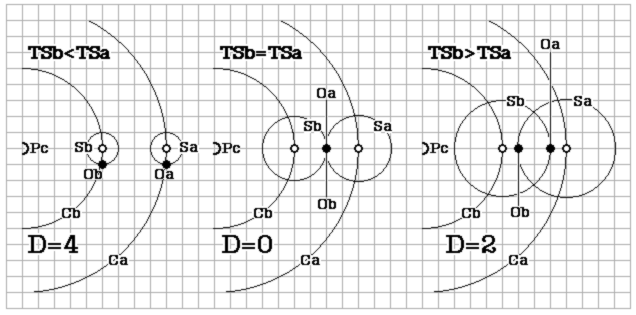
The most attractive aspect of the Pulsating Orbits is that the two universes can sometimes share the same temporal position “T”, regularly putting them in perfect harmony and thus favouring Passages. However, this solution does not have a matching counterpart in known natural phenomena, and the scientific community has been reluctant to adopt it.
But it was to forget a most important aspect of the question: a sphere is an object that has three dimensions in space!
What would happen if points Oa and Ob rest, not on circles, but on intangible orbs? As long as their rotation axis remains perpendicular to the orbital plane, there is no difference. But let this axis shift or be transposed on the sphere, and we are then faced with considerable variations.
Samaris, near the Equator, revolves around the axis of our world faster than northbound København (we take it for granted that the Obscure World is spherical, despite some obtuse minds that claim otherwise). Presumably, the same applies to the cities of the Other World. According to some information gathered by the researcher Henri Menta, our colleagues of the Lighted Universe think that the axis of their Earth has shifted more than once in the course of its history. Portions of the globe that used to lie in the Tropics are now close to one of the Poles; meaning that they now accomplish smaller circles around the new axis of rotation (fig. 8).
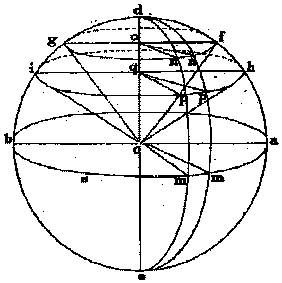
With this vital factor factored in, the calculation of the value “D” at any given time becomes extremely easy. We only need to
39
[ end of original page ]
Analysis
analysis by Sylvain St-Pierre
What to think? Is this document genuine? And, if it is, can we consider as valid ones the various theories proposed? Regarding the second question, we have nothing but conjunctures; there is simply not enough information available on this subject. It is in fact curious that the text should cut off just before reaching the conversion formula that would allow us to solve the thorny problem of temporal equivalence.
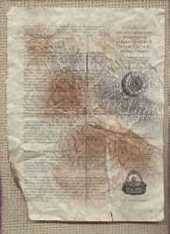 The document as found 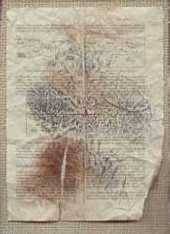 The document as found 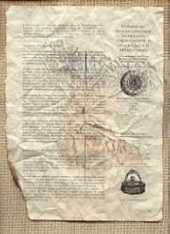 and after restauration 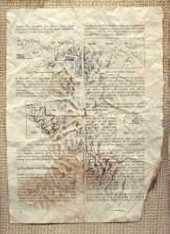 and after restauration |
This leads us to pay a closer attention to those pages, in an effort to answer our first question. Here is what a minute examination of the sheet has revealed:
Tear
 One of the edges of the sheet has been carefully sheared, which seems to indicate that it was originally part of a permanently bound work, either sewed, stapled or glued.
One of the edges of the sheet has been carefully sheared, which seems to indicate that it was originally part of a permanently bound work, either sewed, stapled or glued.
Paper
It is of a type equivalent to that used for good quality letterhead, rather than one of the varieties used in our world for books, magazines or newspapers. The yellowish colour is apparently original, and not caused by the ageing process. It has been impossible to identify for certain from which kind of wood its pulp has been made.
Page numbering
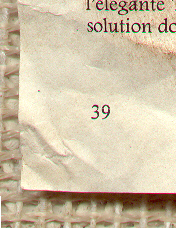 The page numbers do not seem to follow the convention universally accepted in our world, which is to always give an even number to left-hand pages and an odd one to those on the right side. This conclusion is based on the position of the sheared edge and of the page numbers themselves.
The page numbers do not seem to follow the convention universally accepted in our world, which is to always give an even number to left-hand pages and an odd one to those on the right side. This conclusion is based on the position of the sheared edge and of the page numbers themselves.
Format
The dimensions of the page (20 x 27,8 centimeters) do not correspond to any of the standards known here. They could however have been obtained by cutting away from a North-American “letter” size sheet (8 1/2 x 11 inches). The page may possibly have originally been wider before being thorn.
Watermark
The weave of the paper includes a device - visible under ultraviolet light - that is curious indeed, but which sheds no information on its origin. The fact that this mark is perfectly centered tends however to support the view that the sheet was indeed made from the start to its current dimensions.
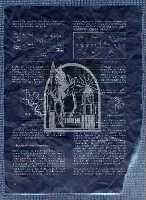 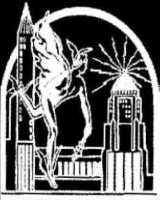 |
Language
The tone is a bit pedantic and the original French slightly archaic, but those are the easiest characteristics to fake. We note the unusual spelling of the word différenciel (differential), normally written “différentiel”, but it may be a voluntary play on words; the word ciel meaning “sky”, or “heaven”.
Printing process
The document has been made with the help of an actual press, for the characters are depressed in the paper and not just “painted” on its surface. There is a slight offset of about 3mm between the two sides of the page, as if the plates or the sheets had not been properly aligned.
Lettering
The font used is somewhat obsolete in our world, but not too difficult to find. Our own “Footlight MT Light”, which was used for the transcription, is practicaly identical. The fact that we are talking about metal characters rather than computer generated letters makes the task a bit more complicated, but not impossible.
Ink
The most remarkable characteristic of the ink is that it is entirely mineral in composition, without any synthetic inclusion. However, none of the components is unknown, and any chemist a minimum of skill could duplicate the compound.
General state
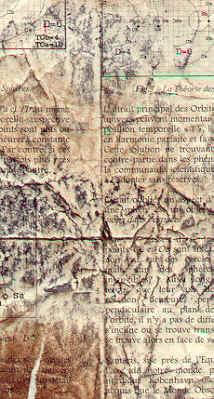 The sheet of paper itself was obviously much battered. It has been folded, crumpled, soiled, walked upon and was spared no indignity! Is this a ploy to age it artificially, or did it truly have such an eventful existence?
The sheet of paper itself was obviously much battered. It has been folded, crumpled, soiled, walked upon and was spared no indignity! Is this a ploy to age it artificially, or did it truly have such an eventful existence?
The soiled spots raise the most questions. Very numerous when the document was first found, they were of a great diversity in nature, and a long series of treatments was necessary to reveal the text that they were hiding. Chemical baths, ultrasonic cleaning, computer enhancement; the best techniques had to be deployed and still did not give an entirely satisfactory result.
Amongst the soiling substances noted, we find some that are close, but not quite identical, to nicotine and caffeine. Before concluding that they have an extra terrestrial origin, it should be considered that tobacco and coffee are choice subjects for genetic engineering, and that there are certainly a great many varieties of these plants not officially recorded.
Text
As mentioned above, it is impossible to check the facts listed in this document. There is however an obvious mistake for Figure 7, the one about Pulsating Orbits. There is no doubt that the labelling of points Oa and Ob has been inverted for TSb>TSa.
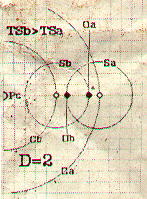
Several of the names quoted, such as Luna, Menta and Theiss, do indeed have a connection with the Obscure World, but this information is widely available elsewhere and does not establish anything. The name of Gøhsay could be a deformation of Gausset, the well-known researcher, but this is only conjuncture. While Professor Stone and his Immaterial Studies College are not known to us, this does prove anything either way, given what little we know about the Continent.
We therefore leave to the reader the task of deciding what he or she wishes to think about the matter.
